tow AUDI A4 2020 User Guide
[x] Cancel search | Manufacturer: AUDI, Model Year: 2020, Model line: A4, Model: AUDI A4 2020Pages: 296, PDF Size: 80.45 MB
Page 54 of 296
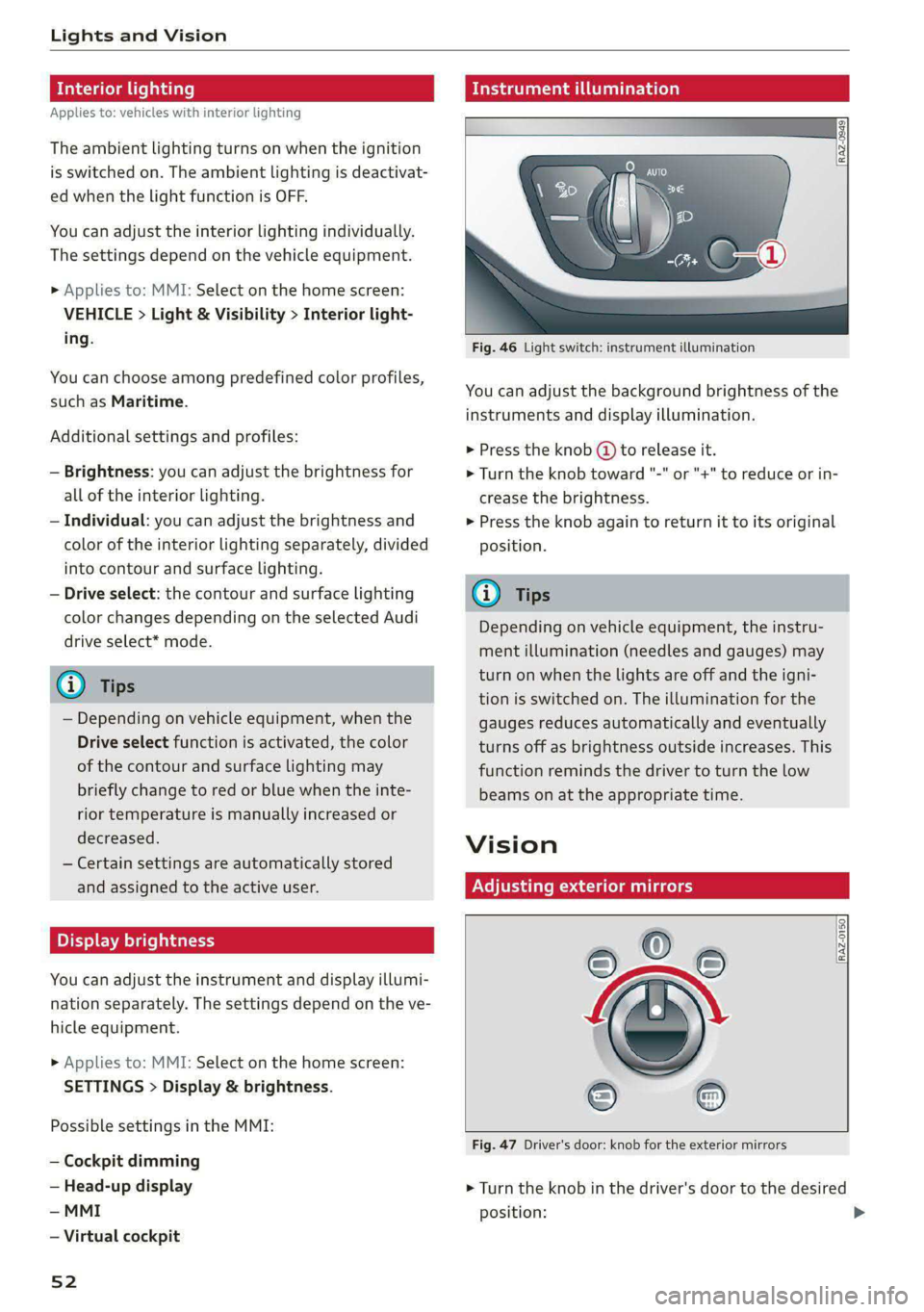
Lights and Vision
Interior lighting
Applies to: vehicles with interior lighting
The ambient lighting turns on when the ignition
is switched on. The ambient lighting is deactivat-
ed when the light function is OFF.
You can adjust the interior lighting individually.
The settings depend on the vehicle equipment.
> Applies to: MMI: Select on the home screen:
VEHICLE > Light & Visibility > Interior light-
ing.
You can choose among predefined color profiles,
such as Maritime.
Additional settings and profiles:
— Brightness: you can adjust the brightness for
all of the interior lighting.
— Individual: you can adjust the brightness and
color of the interior lighting separately, divided
into contour and surface lighting.
— Drive select: the contour and surface lighting
color changes depending on the selected Audi
drive select* mode.
@ Tips
— Depending on vehicle equipment, when the
Drive select function is activated, the color
of the contour and surface lighting may
briefly change to red or blue when the inte-
rior temperature is manually increased or
decreased.
— Certain settings are automatically stored
and assigned to the active user.
Display brightness
You can adjust the instrument and display illumi-
nation separately. The settings depend on the ve-
hicle equipment.
> Applies to: MMI: Select on the home screen:
SETTINGS > Display & brightness.
Possible settings in the MMI:
— Cockpit dimming
— Head-up display
—MMI
— Virtual cockpit
52
Mideast ar a
Fig. 46 Light switch: instrument illumination
You can adjust the background brightness of the
instruments and display illumination.
> Press the knob (@ to release it.
> Turn the knob toward "-" or "+" to reduce or in-
crease the brightness.
> Press the knob again to return it to its original
position.
@ Tips
Depending on vehicle equipment, the instru-
ment illumination (needles and gauges) may
turn on when the lights are off and the igni-
tion is switched on. The illumination for the
gauges reduces automatically and eventually
turns off as brightness outside increases. This
function reminds the driver to turn the low
beams on at the appropriate time.
Vision
Adjusting exterior mirrors
RAZ-0150
Fig. 47 Driver's door: knob for the exterior mirrors
> Turn the knob in the driver's door to the desired
position:
Page 65 of 296

8W1012721BB
Sitting correctly and safely
— Push the lever upward firmly so that the
steering wheel position does not change un-
intentionally while driving, which would in-
crease the risk of an accident.
Head restraints
General information
Applies to: vehicles with adjustable head restraints
B4G-0454
Fig. 60 Correctly adjusted head restraints
Make sure that:
— The upper edge of the head restraint is as even
as possible with the top of your head
— The head restraint is as close as possible to the
back of the head
— The head restraints in any occupied rear seats
are all the way up
Z\ WARNING
— There is one head restraint for each seating
position. All vehicle occupants must adjust
the head restraint correctly before every
trip. Having head restraints that are not ad-
justed correctly or not installed in the vehi-
cle increases the risk of a neck injury during
sudden or unexpected driving or braking
maneuvers or in a collision.
— Only remove the rear seat head restraints if
it is necessary to install a child safety seat
=> page 72. Stow the removed head re-
straints securely, for example in the luggage
compartment. Reinstall the head restraints
immediately once the child safety seat has
been removed. Driving without head re-
straints increases the risk of serious neck in-
juries.
Front head restraints
Applies to: vehicles with adjustable head restraints
[RAZ-0683]
Fig. 61 Front seat: adjusting the head restraint
Adjusting the head restraints
Applies to: vehicles with manually adjustable head restraints
> To adjust the head restraint upward or forward,
slide it until it locks into place.
> To adjust the head restraint downward or back-
ward, press the button on the side and slide the
head restraint. Release the button and slide the
head restraint farther until it locks into place.
Rear head restraints
Applies to: vehicles with adjustable head restraints
Fig. 62 Rear seat: adjusting or removing the head restraint
Adjusting the head restraints
> To adjust the head restraint upward, slide it un-
til it locks into place.
> To adjust the head restraint downward, press
the button @) and slide the head restraint. Re-
lease the button and slide the head restraint
farther until it locks into place.
Removing the headrests
Applies to: vehicles with removable head restraints
> Fold the backrest forward slightly > page 82.
> Move the head restraint upward all the way. >
63
Page 74 of 296
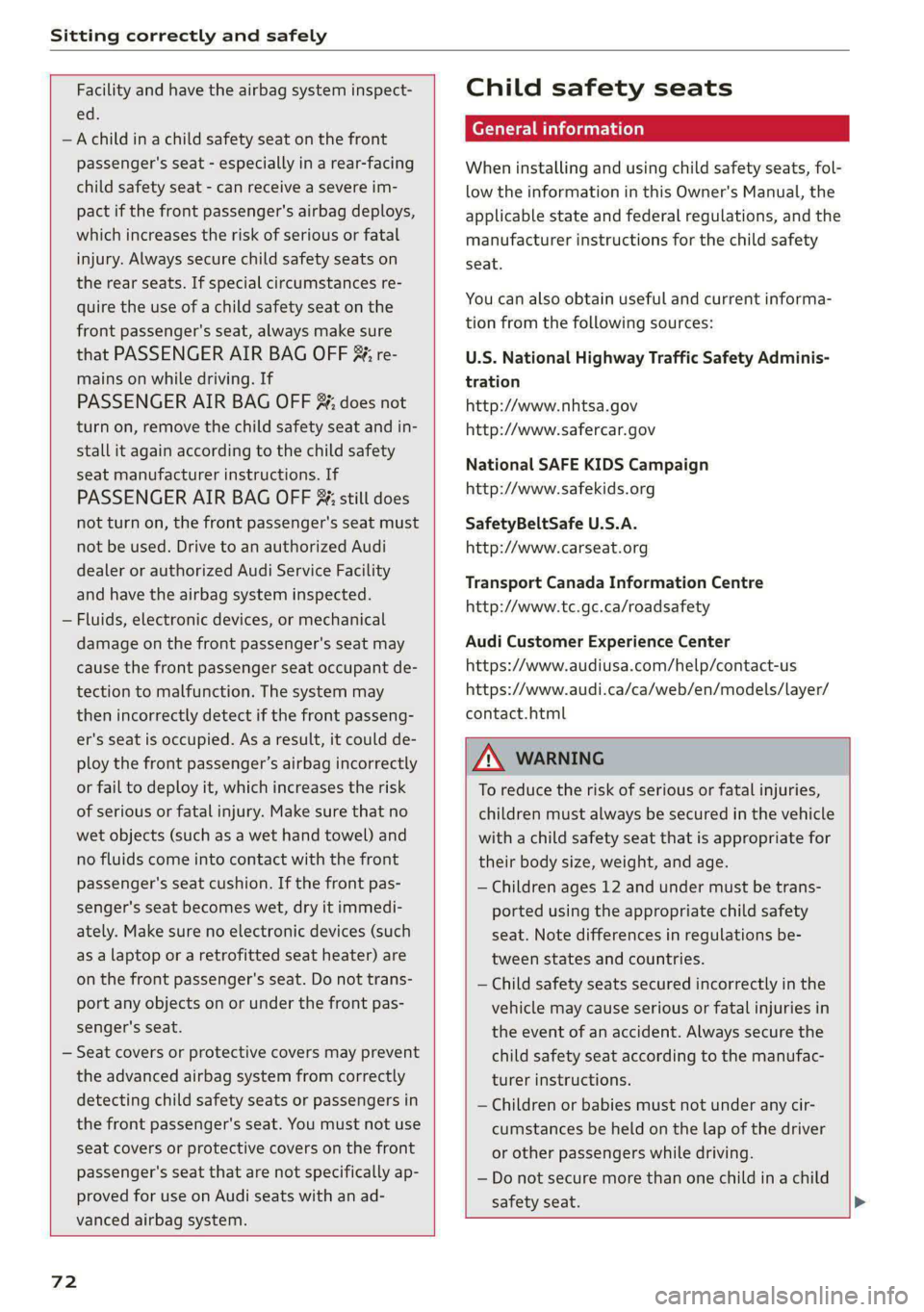
Sitting correctly and safely
Facility and have the airbag system inspect-
ed.
—Achild ina child safety seat on the front
passenger's seat - especially in a rear-facing
child safety seat - can receive a severe im-
pact if the front passenger's airbag deploys,
which increases the risk of serious or fatal
injury. Always secure child safety seats on
the rear seats. If special circumstances re-
quire the use of a child safety seat on the
front passenger's seat, always make sure
that PASSENGER AIR BAG OFF 3%; re-
mains on while driving. If
PASSENGER AIR BAG OFF #, does not
turn on, remove the child safety seat and in-
stall it again according to the child safety
seat manufacturer instructions. If
PASSENGER AIR BAG OFF &%; still does
not turn on, the front passenger's seat must
not be used. Drive to an authorized Audi
dealer or authorized Audi Service Facility
and have the airbag system inspected.
Fluids, electronic devices, or mechanical
damage on the front passenger's seat may
cause the front passenger seat occupant de-
tection to malfunction. The system may
then incorrectly detect if the front passeng-
er's seat is occupied. As a result, it could de-
ploy the front passenger’s airbag incorrectly
or fail to deploy it, which increases the risk
of serious or fatal injury. Make sure that no
wet objects (such as a wet hand towel) and
no fluids come into contact with the front
passenger's seat cushion. If the front pas-
senger's seat becomes wet, dry it immedi-
ately. Make sure no electronic devices (such
as a laptop or a retrofitted seat heater) are
on the front passenger's seat. Do not trans-
port any objects on or under the front pas-
senger's seat.
Seat covers or protective covers may prevent
the advanced airbag system from correctly
detecting child safety seats or passengers in
the front passenger's seat. You must not use
seat covers or protective covers on the front
passenger's seat that are not specifically ap-
proved for use on Audi seats with an ad-
vanced airbag system.
72
Child safety seats
General information
When installing and using child safety seats, fol-
low the information in this Owner's Manual, the
applicable state and federal regulations, and the
manufacturer instructions for the child safety
seat.
You can also obtain useful and current informa-
tion from the following sources:
U.S. National Highway Traffic Safety Adminis-
tration
http://www.nhtsa.gov
http://www.safercar.gov
National SAFE KIDS Campaign
http://www.safekids.org
SafetyBeltSafe U.S.A.
http://www.carseat.org
Transport Canada Information Centre
http://www.tc.gc.ca/roadsafety
Audi Customer Experience Center
https://www.audiusa.com/help/contact-us
https://www.audi.ca/ca/web/en/models/layer/
contact.html
ZA WARNING
To reduce the risk of serious or fatal injuries,
children must always be secured in the vehicle
with a child safety seat that is appropriate for
their body size, weight, and age.
— Children ages 12 and under must be trans-
ported using the appropriate child safety
seat. Note differences in regulations be-
tween states and countries.
— Child safety seats secured incorrectly in the
vehicle may cause serious or fatal injuries in
the event of an accident. Always secure the
child safety seat according to the manufac-
turer instructions.
— Children or babies must not under any cir-
cumstances be held on the lap of the driver
or other passengers while driving.
— Do not secure more than one child in a child
safety seat.
Page 78 of 296
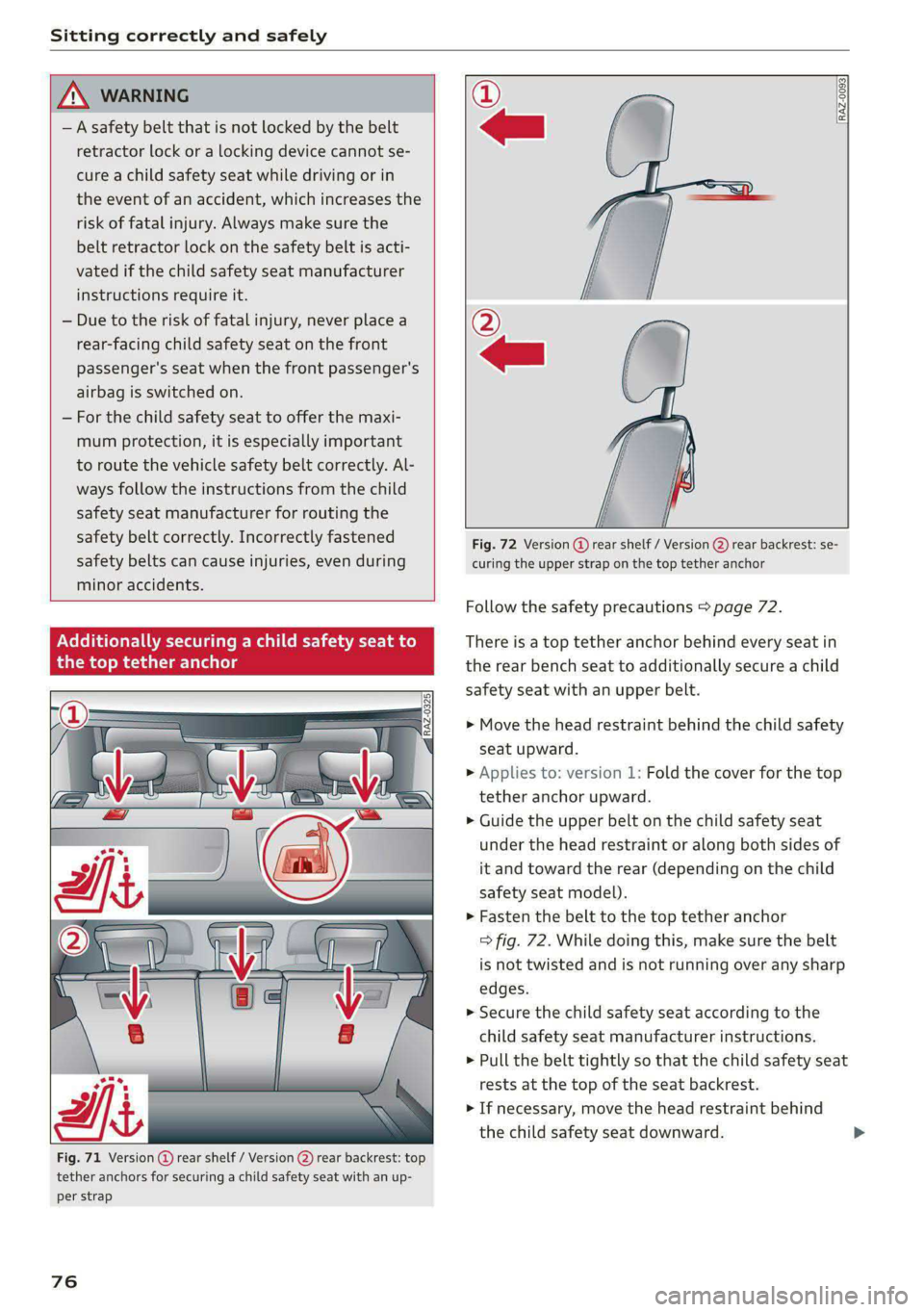
Sitting correctly and safely
ZA WARNING
— A safety belt that is not locked by the belt
retractor lock or a locking device cannot se-
cure a child safety seat while driving or in
the event of an accident, which increases the
risk of fatal injury. Always make sure the
belt retractor lock on the safety belt is acti-
vated if the child safety seat manufacturer
instructions require it.
— Due to the risk of fatal injury, never place a
rear-facing child safety seat on the front
passenger's seat when the front passenger's
airbag is switched on.
— For the child safety seat to offer the maxi-
mum protection, it is especially important
to route the vehicle safety belt correctly. Al-
ways follow the instructions from the child
safety seat manufacturer for routing the
safety belt correctly. Incorrectly fastened
safety belts can cause injuries, even during
minor accidents.
RAZ-0093
Additionally securing a child safety seat to
the top tethe
RAZ-0325)
Fig. 71 Version (@) rear shelf / Version @) rear backrest: top
tether anchors for securing a child safety seat with an up-
per strap
76
Fig. 72 Version @ rear shelf / Version @ rear backrest: se-
curing the upper strap on the top tether anchor
Follow the safety precautions > page 72.
There is a top tether anchor behind every seat in
the rear bench seat to additionally secure a child
safety seat with an upper belt.
> Move the head restraint behind the child safety
seat upward.
> Applies to: version 1: Fold the cover for the top
tether anchor upward.
> Guide the upper belt on the child safety seat
under the head restraint or along both sides of
it and toward the rear (depending on the child
safety seat model).
> Fasten the belt to the top tether anchor
=> fig. 72. While doing this, make sure the belt
is not twisted and is not running over any sharp
edges.
> Secure the child safety seat according to the
child safety seat manufacturer instructions.
> Pull the belt tightly so that the child safety seat
rests at the top of the seat backrest.
» If necessary, move the head restraint behind
the child safety seat downward.
Page 80 of 296

Stowing and using
Stowing and using
Power sources
When the ignition is switched on, you may be
able to use the power sources for external devi-
ces, depending on the vehicle equipment.
12 volt sockets
You can connect electrical accessories to the 12
volt sockets. The power usage must not exceed
120 watts.
The 12 volt sockets are labeled with the 12V
symbol. They are located in the front center con-
sole, in the rear* and on the side trim panel in the
luggage compartment*.
USB ports
Applies to: vehicles with USB input
You can charge mobile devices using the USB
ports. The USB ports are labeled with the «> or
[4 symbol or CHARGE ONLY.
ZA WARNING
—To reduce the risk of fatal injury, store all
connected devices securely when driving so
that they do not move around inside the ve-
hicle when braking or in the event of an acci-
dent.
— Incorrect usage can lead to serious injuries
or burns. To reduce the risk of injuries, never
leave children unattended in the vehicle
with the vehicle key.
@) Note
— Read the operating manuals for the con-
nected devices.
—To reduce the risk of damage to the vehicle
electrical system, never attempt to charge
the vehicle battery by connecting accesso-
ries that provide power to the power sour-
ces.
— Do not connect any device whose network
class (voltage) does not match the network
class designed for the socket.
— Disconnect the connectors from the power
sources carefully to reduce the risk of dam-
aging them.
78
Cup holders
Fig. 74 Rear center armrest*: cup holders
Your vehicle has cup holders in the front center
console and in the rear center armrest*.
Cup holders in the rear center armrest*
> Fold the center armrest* downward.
> To open the cup holders, pull the top cover on
the cup holders forward > fig. 74.
> To close the cup holder, fold the cover back un-
til it clicks into place.
ZX WARNING
— Do not put any hot beverages in the cup
holder while the vehicle is moving. Hot bev-
erages could spill, which increases the risk
of injury.
— Do not use any breakable beverage contain-
ers (for example, made out of glass or por-
celain). You could be injured by them in the
event of an accident.
@) Note
Beverage containers in the cup holders should
always
have a lid. Otherwise, the liquid inside
could spill and cause damage to vehicle
equipment.
Storage areas and
compartments
Depending on the vehicle equipment, there may
be a variety of storage areas, compartments, and
retainers at various locations in the vehicle. >
Page 81 of 296

8W1012721BB
Stowing and using
— Glove compartment: the glove compartment
can be locked using the mechanical key
=> page 34.
— Storage compartments in the door trim panels
— Storage compartment in the center console
— Storage compartment under the front center
armrest
— Storage compartment in the rear center arm-
rest
— Storage compartment under the light switch
— Garment hooks above the rear doors
— Nets on the backrests of the front seats
— Storage compartments behind the rear head re-
straints: the storage compartments can be
used to store lightweight pieces of clothing.
— Nets on the left/right luggage compartment
trim panel
— Tie-downs on the left/right luggage compart-
ment trim panel
— Bag hooks in the luggage compartment
Z\ WARNING
—To reduce the risk of injury, make sure all
storage compartments are always closed
while driving.
— Loose objects can be thrown around the ve-
hicle interior during sudden driving or brak-
ing maneuvers, which increases the risk of
an accident. Store objects securely while
driving.
— Only use the storage compartments in the
door trim panels to store small objects that
will not stick out of the compartment and
impair the function of the side airbags.
— Due to strength reasons, only secure objects
up to 11 lbs (5 kg) with the tie-downs*.
Heavier objects are not adequately secured.
There is risk of personal injury.
— Applies to: vehicles with garment hooks: On-
ly lightweight clothing should be hung from
the garment hooks in the vehicle. Do not use
clothes hangers to hang clothing. The pock-
ets of the clothing must not contain any
heavy, breakable, or sharp-edged objects.
This could impair the effectiveness of the
side curtain airbags.
— Make sure your view toward the rear is not
blocked, for example by hanging clothing or
objects in the vehicle.
— Applies to: vehicles with storage areas be-
hind the rear head restraints: Do not store
any
heavy or hard objects or use to transport
animals. Such objects endanger vehicle oc-
cupants and increase the risk of injury dur-
ing sudden driving or braking maneuvers or
in an accident.
@) Note
Applies to: vehicles with storage areas behind
the rear head restraints: Make sure the heat-
ing grid strips for the rear window defogger
are not damaged by abrasive objects.
@) Tips
Applies to: vehicles with storage areas behind
the rear head restraints: To ensure the venti-
lation functions correctly, the ventilation slots
between the rear window and the storage
area must not be covered.
Luggage compartment
General information
All pieces of luggage or objects must be securely
fastened in the luggage compartment. Note the
following to maintain good vehicle handling:
> Distribute the load evenly in the luggage com-
partment.
> Stow heavy luggage as far forward in the lug-
gage compartment as possible.
> Use non-elastic cords attached to the tie-downs
to secure objects.
ZA\ WARNING
— Applies to: vehicles with luggage compart-
ment cover: The luggage compartment cov-
er is not a surface for storing objects. Ob-
jects placed on the cover increase the risk of
injury to all vehicle occupants during sudden
driving or braking maneuvers or in the event
of an accident. >
79
Page 82 of 296

Stowing and using
— Applies to: vehicles with luggage compart-
ment cover: The luggage compartment cov-
er must always be securely fastened when in
use to reduce the risk of an accident.
— Loose objects can be thrown around the ve-
hicle interior during sudden driving or brak-
ing maneuvers, which increases the risk of
an accident. Always stow objects securely in
the luggage compartment and secure them
at the tie-downs. Use straps suitable for
heavy objects.
— If pieces of luggage or objects are secured
to the tie-downs with unsuitable or dam-
aged straps, this can increase the risk of in-
jury during braking maneuvers or accidents.
— When transporting heavy objects, the vehi-
cle characteristics will change due to the
shift in the center of gravity, which increases
the risk of an accident. You may need to
adapt your driving style and speed to the
current conditions.
— The cargo net is only strong enough to se-
cure light objects. Heavy objects are not ade-
quately secured. Attempting to secure heavy
objects increases the risk of injury.
— Never exceed the permitted axle and load
and vehicle weight > page 278.
— Never secure a child safety seat to the tie-
downs.
— Never leave your vehicle unattended, espe-
cially if the luggage compartment lid is
open. Children could enter the luggage com-
partment and close the luggage compart-
ment lid from the inside. This creates the
risk of fatal injury, since the children would
be locked in and may not be able to escape
by themselves.
— Do not allow children to play in or on the ve-
hicle. Close and lock the luggage compart-
ment lid as well as all other doors when you
leave
the vehicle.
— Never transport passengers in the luggage
compartment. Every passenger must be cor-
rectly secured with the safety belts in the
vehicle > page 64.
— Be careful when releasing the backrest and
folding
it forward. To reduce the risk of be-
ing pinched, pay attention and check when
folding backrests forward.
— The backrest must be securely latched so
objects cannot slide forward out of the lug-
gage compartment during sudden braking.
— The backrest must be latched securely to en-
sure that the safety belt is protecting the
center seating position.
— Always pull forward on the backrest to make
sure it is check if it is correctly locked in
place.
80
() Note
—To reduce the risk of damage, move the rear
head restraints down before folding the rear
backrests forward > page 63.
— When folding the backrest forward, make
sure the outer safety belts are in the belt
guide recess so that they do not get pinched
in the backrest lock and damaged. Other ob-
jects should be removed from the rear
bench seat to protect the backrest from
damage.
— To reduce the risk of damaging the front
seats, make sure there is enough space be-
tween the front seat and the rear seat
equipment when folding the center backrest
forward.
— If you move the front seat back when the
rear seat backrest is folded forward, you
could damage the head restraints on the
rear seat.
— Make sure that the heating grid strips for
the rear window defogger are not damaged
by abrasive objects.
— Applies to: vehicles with manual luggage
compartment cover: Let the luggage com-
partment cover roll up slowly to reduce the
risk of damage.
— Applies to: vehicles with partition net: Let
the partition net roll up slowly to reduce the
risk of damage.
(i) Tips
— The tire pressure must be adapted to the
load > page 237.
— You can purchase straps at specialty stores.
Page 83 of 296
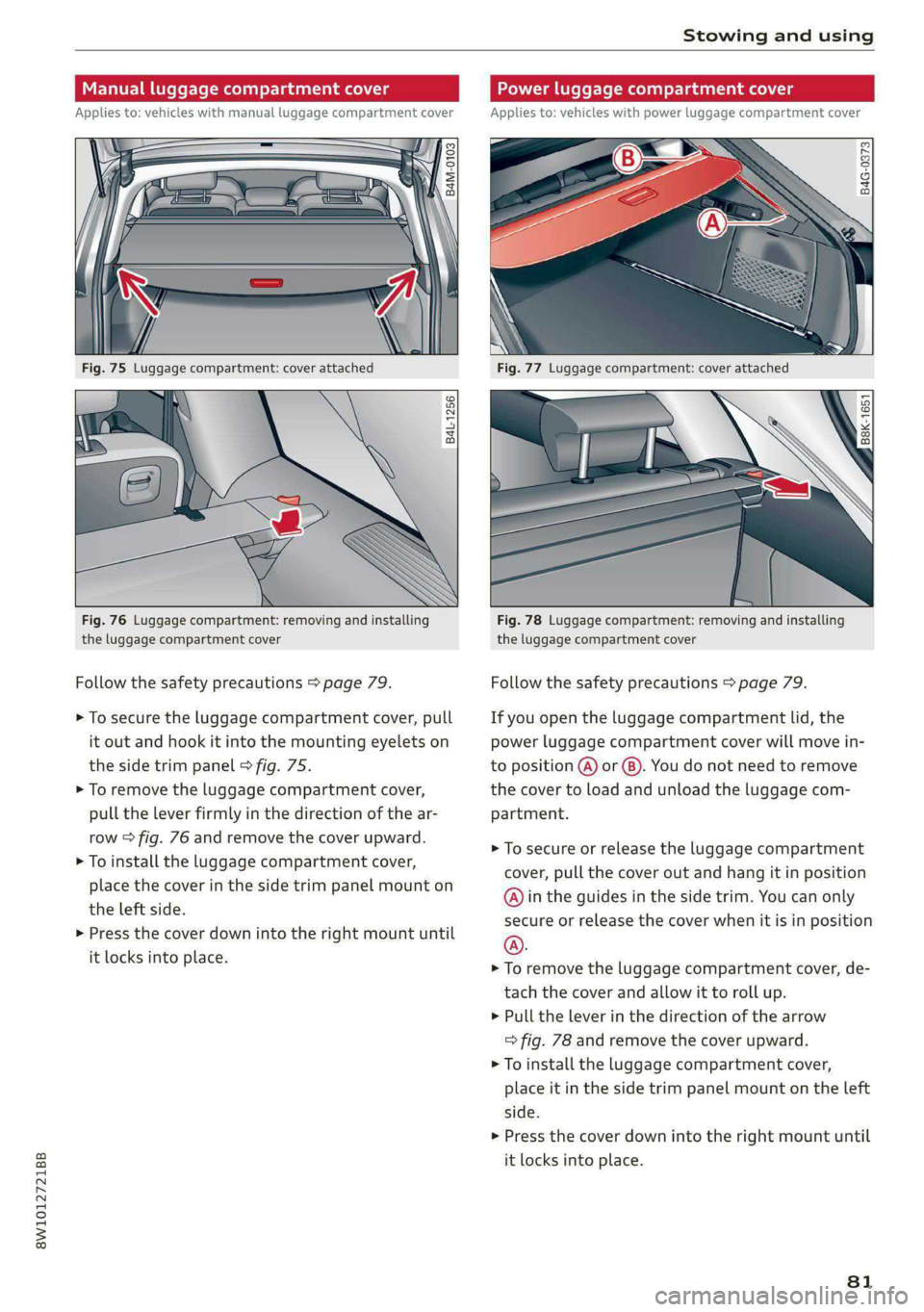
8W1012721BB
Stowing and using
Power luggage compartment cover
Applies to: vehicles with power luggage compartment cover
Manual luggage compartment cover
Applies to: vehicles with manual luggage compartment cover
oO R 2 &
9 + a
Fig. 77 Luggage compartment: cover attached
B4L-1256
AB
Fig. 76 Luggage compartment: removing and installing Fig. 78 Luggage compartment: removing and installing
the luggage compartment cover the luggage compartment cover
Follow the safety precautions > page 79. Follow the safety precautions > page 79.
> To secure the luggage compartment cover, pull If you open the luggage compartment lid, the
it out and hook it into the mounting eyelets on power luggage compartment cover will move in-
the side trim panel > fig. 75. to position @) or (8). You do not need to remove
> To remove the luggage compartment cover, the cover to load and unload the luggage com-
pull the lever firmly in the direction of the ar- partment.
row > fig. 76 and remove the cover upward.
. > To secure or release the luggage compartment
> To install the luggage compartment cover,
lace th in the side tri [ « cover, pull the cover out and hang it in position
PABee EUS COVSE IN ME ee SINR ENS: MOA Ne On @ in the guides in the side trim. You can only
theileft.side: . . . secure or release the cover when it is in position
> Press the cover down into the right mount until ®
felocksiinto place: > To remove the luggage compartment cover, de-
tach the cover and allow it to roll up.
> Pull the lever in the direction of the arrow
=> fig. 78 and remove the cover upward.
> To install the luggage compartment cover,
place it in the side trim panel mount on the left
side.
> Press the cover down into the right mount until
it locks into place.
81
Page 84 of 296

Stowing and using
easing the size of the vehicle inter
Applies to: vehicles with folding backrests
oO aD R % ©
oO
Fig. 80 Center backrest: folding the center backrest for-
ward
The rear seat backrests can be folded forward ei-
ther separately* or together.
Follow
the safety precautions > page 79.
Folding the outer rear backrests forward and
backward
> Pull the release lever (@) in the direction of the
arrow and fold the backrest forward. Let the
backrest latch into the lowest position.
> Fold the backrest back up again until it locks in-
to place and the red marking (@) is no longer
visible.
Folding the center rear backrest forward and
backward
> Pull on the upper release lever @) and fold the
backrest forward (@).
>» Fold the backrest backward until it locks into
place.
Applies to: vehicles with lockable backrests in the rear and a
lockable pass-through.
To prevent access to the luggage compartment
from the vehicle interior, the backrest can be
82
locked with the mechanical key © when it is
latched in place and the pass-through can be
locked > page 84. You can only enlarge the lug-
gage compartment if the backrest is not locked.
reasing the size of the hs Is)
compartme
Applies to: vehicles with release lever in the luggage compart-
ment
| BEW-0268
Fig. 81 Luggage compartment: release lever
The rear seat backrests can be folded forward ei-
ther separately* or together.
Follow
the safety precautions > page 79.
> Pull the release lever > fig. 81 in the direction
of the arrow to fold the backrest forward.
> To set up the backrest again, fold it back until it
locks or the red marking (8) = page 82, fig. 79
is no longer visible.
Page 85 of 296
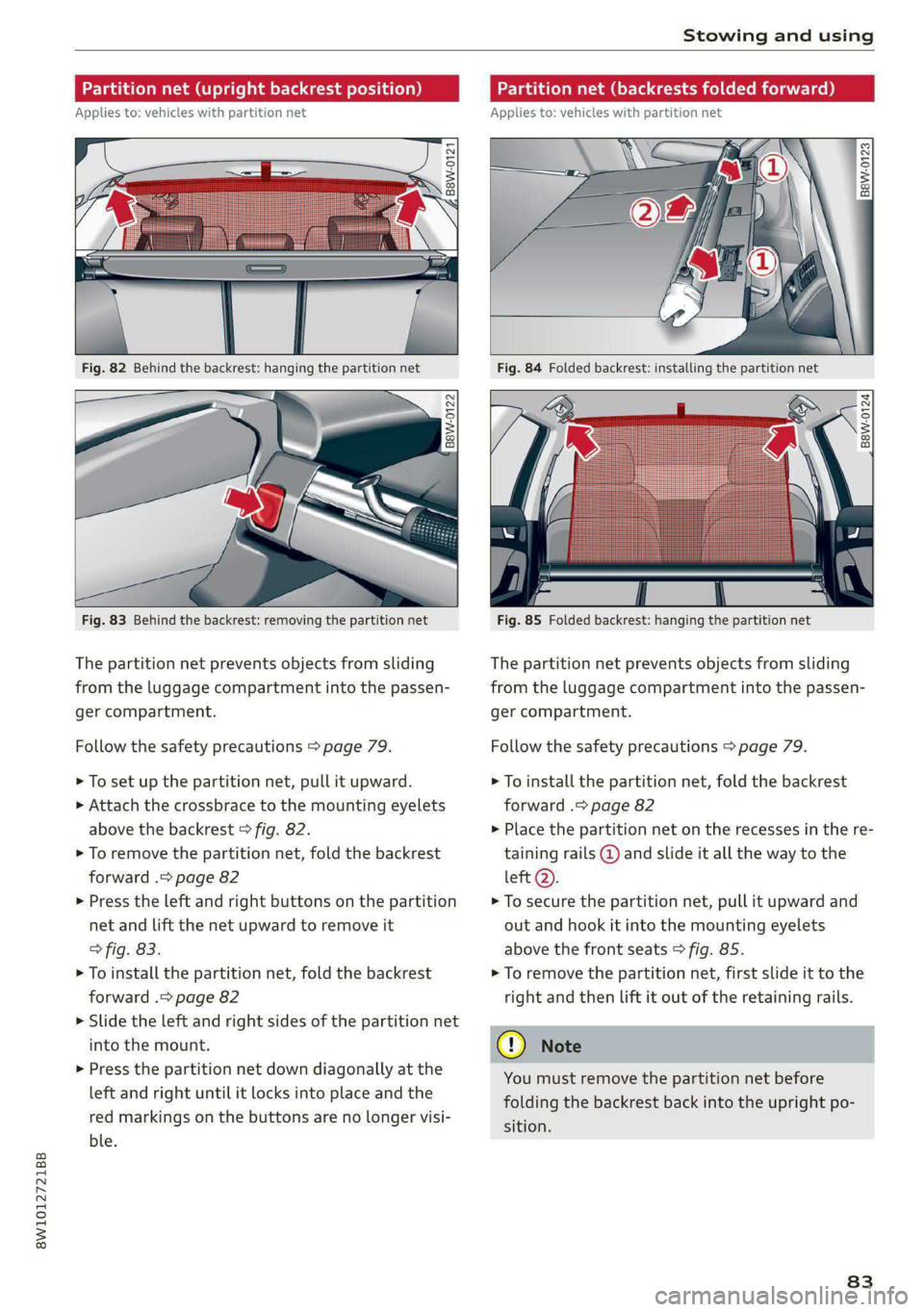
8W1012721BB
Stowing and using
Partition net (upright backrest position)
Applies to: vehicles with partition net
B8W-0121
‘ 2
Fig. 82 Behind the backrest: hanging the partition net
B8W-0122
Fig. 83 Behind the backrest: removing the partition net
The partition net prevents objects from sliding
from the luggage compartment into the passen-
ger compartment.
Follow the safety precautions > page 79.
> To set up the partition net, pull it upward.
> Attach the crossbrace to the mounting eyelets
above the backrest > fig. 82.
> To remove the partition net, fold the backrest
forward .> page 82
> Press the left and right buttons on the partition
net and lift the net upward to remove it
> fig. 83.
> To install the partition net, fold the backrest
forward .> page 82
> Slide the left and right sides of the partition net
into the mount.
> Press the partition net down diagonally at the
left and right until it locks into place and the
red markings on the buttons are no longer visi-
ble.
Partition net (backrests folded forward)
Applies to: vehicles with partition net
B8W-0123
Fig. 84 Folded backrest: installing the partition net
. %
B8W-0124
Fig. 85 Folded backrest: hanging the partition net
The partition net prevents objects from sliding
from the luggage compartment into the passen-
ger compartment.
Follow the safety precautions > page 79.
> To install the partition net, fold the backrest
forward .> page 82
> Place the partition net on the recesses in the re-
taining rails @ and slide it all the way to the
left Q).
> To secure the partition net, pull it upward and
out and hook it into the mounting eyelets
above the front seats > fig. 85.
> To remove the partition net, first slide it to the
right and then lift it out of the retaining rails.
You must remove the partition net before
folding the backrest back into the upright po-
sition.
83